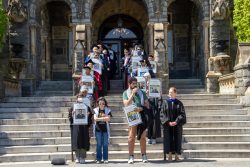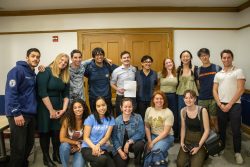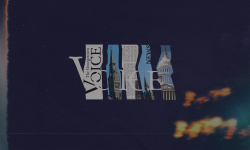Likeness of West Bank barrier stirs debate
In the early afternoon on Tuesday, students passing through Red Square encountered a towering 20 foot representation of the separation barrier built between the West Bank and the rest of the country.
In the background, the voice of Ziad Abu Rish, a Georgetown graduate student and a member of Students for Justice in Palestine, resonated across the square, broadcasting SJP’s protest of the barrier.


photo by Michael Keller
Hammad Hammad (SFS ’08), president of SJP, said that the replica barrier was erected to encourage dialogue. Students had several reactions.
“The good reactions were people asking questions, asking about the facts,” he said. Many students of all political orientations approached him and other SJP students at the protest in order to discuss the barrier and its impact on Israelis and Palestinians.
Mariam Asmar (SFS ’08), a member of SJP who handed out fliers during the protest, said that the replica was an important way to encourage people to reflect on what she saw as the dehumanizing power of the barrier.
“When you can put a face to a victim, it makes a big difference. The wall prevents that,” she said.
Mark Lerner (SFS ’09), President of Political Affairs for the Georgetown-Israel Alliance, disagreed.
“That actually does the exact opposite of encouraging dialogue,” he said in a telephone interview, citing the SJP’s portrayal of Israel as an apartheid state. “Why would you want to have dialogue with an apartheid state?”
Members of GIA put up fliers on Monday morning in Red Square protesting President Jimmy Carter’s book, Palestinian Peace, Not Apartheid, a critique of the barrier which came out on Tuesday.
“The message that they had, in response to Jimmy Carter’s book, [is that] the wall is a barrier for security,” Lerner said. “The goal isn’t to separate two people and two cultures. It’s to protect against terrorism.”
The fliers included slogans like “Terrorism Built Israel’s Security Fence” and “The Security Barrier brought successful terrorist attacks down by 95%.”
Asmar said that although Israel erected the barrier in response to suicide bombings, it is still necessary to ask what provoked the bombings. It is this kind of dialogue, as well as increased awareness, that the SJP was seeking to promote, she said.
Lerner said that he found aspects of the protest offensive, as well as parts of the presentation. He recently lost a friend in a bombing, and felt that the depiction of the barrier as an unadulterated evil did not take into account the feelings of those who had lost friends and family in the conflict.
Lerner said that the replica in the Red Square protest is not representative of the actual barrier. He said that only 3.8 percent of it is actually a wall, while the rest of it is simply a fence.
Overall, Hammad said that he felt the event was a success.
Although it was marred by some negative reactions, the dialogue that was encouraged outweighed the conflicts he said. He even spoke with Rabbi Harold White, Georgetown’s Senior Jewish Chaplain, in what he called a very positive discussion.




